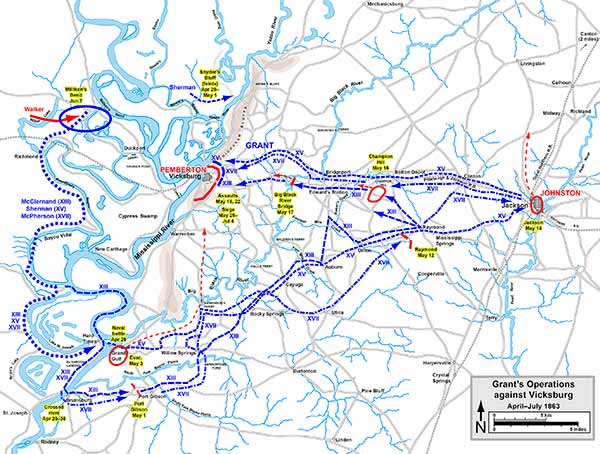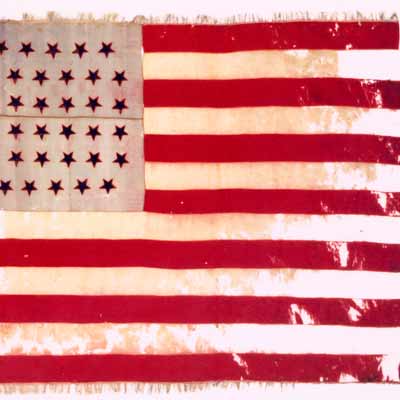
(Map of the second half of the Vicksburg Campaign. Great Great Grandfather’s Ohio unit moved from Memphis to Young’s Point, LA, in April and then participated in Grant’s long left hook through Jackson, MS, and then into the siege lines around the Gibraltar of the Mississippi River that resulted in the surrender of the city on the 4th of July. That day in 1863, following the defeat of Robert E. Lee’s army at Gettysburg the day before, marked the turning point of the war. Map drawn in Adobe Illustrator CS6 by Hal Jespersen for the USG).
Before we go on, I should mention that the 72nd Ohio Volunteer Infantry saved the Union. Oh, I know. This is chaotic. We did the bit in the middle of this story weeks ago, and cover the events long before that just a week ago. Sorry.
And the other thing- the 72nd OVI was an outfit I considered the Rodney Dangerfield of the Union infantry. It was not the most famous Ohio regiment to fight in the Civil War, nor the most decorated, but on the first day of the fighting at Shiloh (Pittsburg Landing) it bore the brunt of Albert Sidney Johnston’s furious assault. Under heavy fire, the regiment was pushed back beyond its camp. In the afternoon, in conjunction with McClernand’s division, it mounted a determined counterattack.
Remaining under heavy fire the entire day, the 72nd suffered heavy casualties, including the loss of its commanding general. At the end it held the line, allowing Lew Wallace’s division to come onto the field of battle and giving the surprised Grant time to reform his shattered troops at Pittsburgh Landing.
If the men of the 72nd OVI had not rallied, Grant’s entire right wing would have collapsed and his force would have been destroyed, leaving the West securely in Confederate hands. So, if I say that Grandfather James saved the Union, I can make a case for it.
When I wrote before, I thought the unit was with Wallace, since they were listed as being at Crump’s landing. They were not. They were with Sherman, positioned on the right flank of Grant’s army. Sorry. There will be several revisions to all this before it is a real book, but the labor goes on. It is a voyage on the long river of history.
So, today it is Grant’s Operations against Vicksburg.
As the Union forces approached Vicksburg, Confederate General John C. Pemberton could put only 18,500 troops in his lines. Grant had over 35,000, including James, with more on the way. However, Pemberton had the advantage of terrain and fortifications that made his defense nearly impregnable.
Pemberton, trying to please Jefferson Davis, who insisted that Vicksburg and Port Hudson must be held, and to please Johnston, who thought both places worthless militarily, had been caught in the middle, a victim of a convoluted command system and his own indecisiveness. Too dispirited to think clearly, he chose to back his bedraggled army into Vicksburg rather than evacuate the city and head north where he might have escaped to campaign again. When he chose to take his army into Vicksburg, Pemberton sealed the fate of his troops and the city he had been determined to defend.
– Vicksburg, Michael B. Ballard.
Of course, hunger and starvation trumps the advantage of terrain over time.
After crossing the Mississippi River south of Vicksburg at Bruinsburg in the largest amphibious operation in American history (and which would remain the largest until D-Day) and driving northeast, Grant won battles at Port Gibson and Raymond, capturing Uncle Patrick. Then he captured the state capital at Jackson.
Pemberton was forced to withdraw westward to avoid being flanked by Sherman. He fought desperately at Champion Hill and Big Black River, where he withdrew after burning the bridges. He took everything edible in his path, fruit grain and four-legged.
The Confederates evacuated Hayne’s Bluff, which was occupied by Sherman’s cavalry on May 19, and Union steamboats no longer had to run the guns of Vicksburg, now being able to dock by the dozens up the Yazoo. Grant could now receive supplies directly from Union depots to the south, and he was prepared to invest the city and starve Pemberton out.
Over three quarters of Pemberton’s army had been lost in the two preceding battles and many in Vicksburg expected General Joe Johnston, commander of the Department of the West to come to their relief. He did not, and instead Johnston sent a note to Pemberton asking him to sacrifice the city and save his troops. Pemberton was a Northerner by birth, and could have been influenced by his fear of public condemnation if he abandoned the city.
Vicksburg was an imposing objective. The defensive line ran approximately 6.5 miles, and included many gun pits, forts, trenches, redoubts and. The major fortifications of the line included Fort Hill, on a high bluff north of the city; the Stockade Redan, dominating the approach to the city on Graveyard Road from the northeast; the 3rd Louisiana Redan; the Great Redoubt; the Railroad Redoubt protecting the gap for the railroad line entering the city; the Square Fort (Fort Garrott); a salient along the Hall’s Ferry Road; and the South Fort.
The 72nd was there. More on that tomorrow.

(National colors of the 72nd Ohio Volunteer Infantry held at the Ohio Historical Society, Columbus, Ohio).
Copyright 2015 Vic Socotra
www.vicsocotra.com
Twitter: @jayare303
